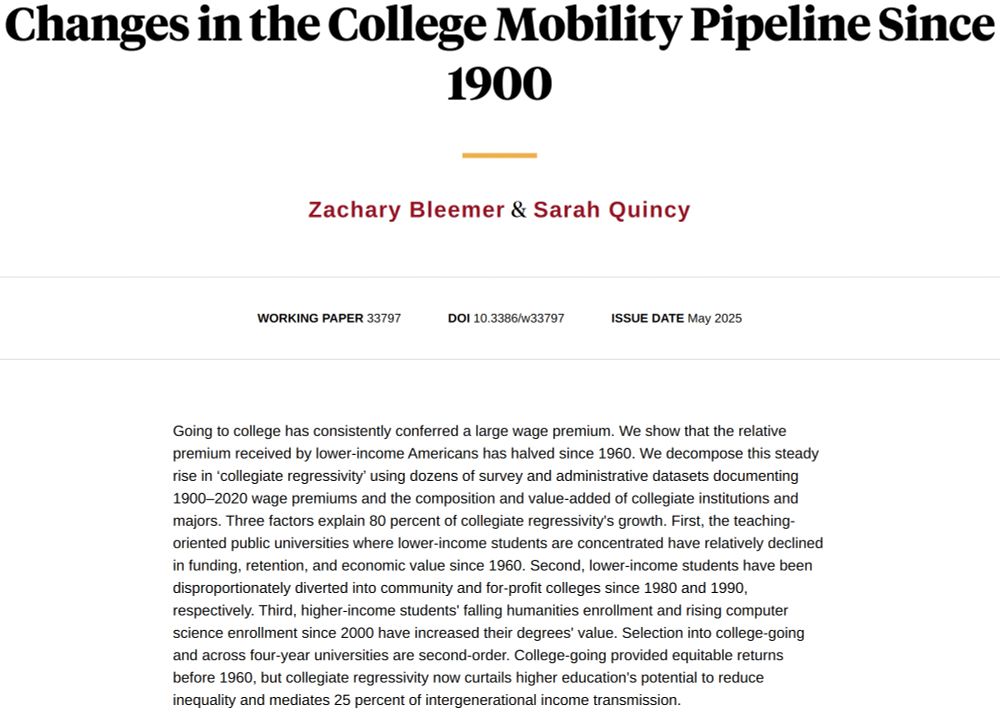This is why going to college has become less valuable for poor students.

This is why going to college has become less valuable for poor students.
Poor students' diversion to these lower-value colleges explains about 20% of the rise in collegiate regressivity.

Poor students' diversion to these lower-value colleges explains about 20% of the rise in collegiate regressivity.
Students who attend these schools derive lower value-added from them. Since the 1980s, those students have been disproportionately poor.

Students who attend these schools derive lower value-added from them. Since the 1980s, those students have been disproportionately poor.
Possibly for the first time ever, poor students are now more likely to be humanities majors than rich students.
That's bad for economic mobility.

Possibly for the first time ever, poor students are now more likely to be humanities majors than rich students.
That's bad for economic mobility.
Today, though, poor students earn much lower-paying majors than the rich. This explains 25% of regressivity.
Two disciplines are most at fault: humanities and computer science.

Today, though, poor students earn much lower-paying majors than the rich. This explains 25% of regressivity.
Two disciplines are most at fault: humanities and computer science.
There are huge differences in wage value across majors. They haven't changed much over time.
Humanities at the bottom. Engineering at the top. The gap has widened.

There are huge differences in wage value across majors. They haven't changed much over time.
Humanities at the bottom. Engineering at the top. The gap has widened.
But using current value-added, poor students attend lower-value uni's.
Teaching-oriented publics' deterioration explains 30% of collegiate regressivity.

But using current value-added, poor students attend lower-value uni's.
Teaching-oriented publics' deterioration explains 30% of collegiate regressivity.
That money buys value. We measure colleges' "value-added": the degree to which they increase future wages.
Poor students' colleges' value has fallen.

That money buys value. We measure colleges' "value-added": the degree to which they increase future wages.
Poor students' colleges' value has fallen.
Rich students have always mostly attended private and research public universities. Poor students mostly go to teaching-oriented publics.
That's still true. But the teaching-oriented publics have deteriorated in value.

Rich students have always mostly attended private and research public universities. Poor students mostly go to teaching-oriented publics.
That's still true. But the teaching-oriented publics have deteriorated in value.
Between 1920 and 1960, the premium was equal for the rich and poor. It's been getting more regressive since then.
Three factors explain the trend:

Between 1920 and 1960, the premium was equal for the rich and poor. It's been getting more regressive since then.
Three factors explain the trend:
The data include the parental income, college, major, and early-30s wages of hundreds of thousands of Americans.

The data include the parental income, college, major, and early-30s wages of hundreds of thousands of Americans.
Today, the wage premium has grown for the rich but sharply fallen for the poor. We call this "collegiate regressivity".

Today, the wage premium has grown for the rich but sharply fallen for the poor. We call this "collegiate regressivity".
What is to blame? Rising selectivity? Tuition hikes? State disinvestment? We decompose changes in the premium since 1900 to find out.
🧵#EconTwitter nber.org/papers/w33797

What is to blame? Rising selectivity? Tuition hikes? State disinvestment? We decompose changes in the premium since 1900 to find out.
🧵#EconTwitter nber.org/papers/w33797
Premiums rose even faster than that, though; up $5k in inflation-adjusted dollars. That killed a million jobs in all.

Premiums rose even faster than that, though; up $5k in inflation-adjusted dollars. That killed a million jobs in all.
Some of those workers find work at less-exposed competitor firms, but half remain unemployed or turn to self-employment.

Some of those workers find work at less-exposed competitor firms, but half remain unemployed or turn to self-employment.
She finds that current employees' wages were unaffected. New employees took a 5% pay cut, but this is still only a 20% pass-through of the additional premiums.

She finds that current employees' wages were unaffected. New employees took a 5% pay cut, but this is still only a 20% pass-through of the additional premiums.
After those mergers, annual healthcare premiums in those markets rose by over $400 per enrollee, or 10%. Quality did not improve.

After those mergers, annual healthcare premiums in those markets rose by over $400 per enrollee, or 10%. Quality did not improve.
This doesn't matter for low-wage employment; they don't get health benefits. And it's only a small share of the wage bill of high-wage employees.
But the relative cost of middle-income workers has skyrocketed.

This doesn't matter for low-wage employment; they don't get health benefits. And it's only a small share of the wage bill of high-wage employees.
But the relative cost of middle-income workers has skyrocketed.
A great new (job market!) paper by Jessica Min tells the story. 🧵
jessica-min.com
#EconTwitter

A great new (job market!) paper by Jessica Min tells the story. 🧵
jessica-min.com
#EconTwitter

